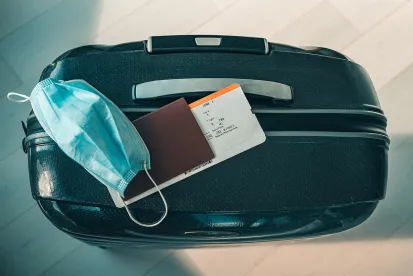As a follow-up to the announcement discussed in our September 22, 2021 alert, the White House confirmed on Monday, October 25, that it will eliminate all COVID-19-related travel bans effective at 12:01 am Eastern Standard Time on Monday, November 8, 2021. The official Presidential Proclamation can be found here.
This new Proclamation relies on U.S. Center for Disease Control (“CDC”) guidance for vaccination and negative testing criteria as referenced in the links below.
-
The CDC’s general page for COVID-19 exposure related to travel can be found here.
-
There is also a helpful CDC document with technical instructions to airlines that can be found here.
As indicated in our previous alert, this new Proclamation is confirmation of the revamping of travel restrictions for international travelers entering the United States and specifically addresses “noncitizen nonimmigrants” since travel guidance is already in place for U.S. citizens and permanent residents. The new policy replaces the country-specific travel bans with a policy that applies to all individuals, regardless of country of origin or physical presence. In exchange for country-specific bans, this new policy will be based on vaccination status and testing negative for COVID-19.
By way of background, the Trump and Biden administrations have implemented numerous COVID-19-related travel bans over the past 18 months. These travel bans require that individuals present in any of the impacted regions or countries either obtain an exception to the ban or quarantine in a third country for 14 days prior to entering the United States. There are a number of individuals who are exempt from these bans, including U.S. citizens, permanent residents, and certain close relatives of U.S. citizens and permanent residents.
Our immigration resources page has a broad overview of all current U.S. travel bans.
New White House Travel Policy Focuses on Individual Requirements for Entry to the U.S.
Under this policy, vaccinated or unvaccinated U.S. citizens and U.S. permanent residents may still enter the U.S. Unvaccinated citizens and permanent residents must comply with more stringent COVID-19 testing requirements.
The new policy taking effect on November 8 addresses “noncitizens who are nonimmigrants.” Nonimmigrants are individuals who are entering the U.S. on a temporary visa status. This policy potentially leaves a gap in addressing individuals entering the U.S. in a different category, such as refugees, asylees, and parolees. More guidance is likely forthcoming on these classes of individuals.
The new policy focuses on an individual’s vaccination status. Nonimmigrant travelers to the U.S. must prove that they have been fully vaccinated against COVID-19, as defined by the CDC here. Furthermore, all passengers by air age two or over — regardless of citizenship or vaccination status — must show a negative COVID-19 viral test or documentation of recovery from COVID-19 prior to boarding a flight to the U.S. The CDC’s guidelines for negative testing and proof of recovery from COVID-19 can be found here.
In limited situations, unvaccinated nonimmigrant travelers may still enter the U.S., but they must meet certain exception criteria and comply with additional restrictions. The new Proclamation’s general rule is unvaccinated nonimmigrants are not permitted to enter the U.S. The exceptions permitting unvaccinated nonimmigrants to enter the U.S. include persons on diplomatic or official foreign government travel, children under age 18, those with documented medical contraindications for receiving a vaccination, participants in certain COVID-19 vaccine trials, those issued a humanitarian or emergency exception, those entering on valid visas (other than visitors for business or tourism) from countries with limited vaccine availability, members of the U.S. Armed Forces and their spouses and children, crew members traveling by sea, and others whose entry is in the national interest of the U.S.
Presumably, the CDC will issue further guidance on some of the exceptions above, such as individuals traveling from countries with limited vaccine availability. Those meeting one of these exceptions must also comply with additional requirements, including pre-departure COVID-19 testing, taking extra precautions during air travel such as wearing a face mask, proof of having arranged post-arrival testing for COVID-19, and proof of having arranged self-quarantine or self-isolation after arrival. These additional steps must meet current CDC guidelines.
The current travel ban, which has been in place since the earliest days of the pandemic, creates significant burdens for many individuals who are present in a country or region that is subject to a COVID travel ban. The suspension of entry for foreign nationals currently applies to physical presence in the following countries: China (excluding Hong Kong and Macau), Iran, Brazil, India, the United Kingdom, Ireland, South Africa, and the Schengen area of Europe comprising Austria, Belgium, Czech Republic, Denmark, Estonia, Finland, France, Germany, Greece, Hungary, Iceland, Italy, Latvia, Liechtenstein, Lithuania, Luxembourg, Malta, Netherlands, Norway, Poland, Portugal, Slovakia, Slovenia, Spain, Sweden, and Switzerland.
In related news, on October 12, 2021, the Department of Homeland Security (DHS) announced the end of closed borders between the U.S., Mexico, and Canada to non-essential travelers. These land borders have been closed to visitors for recreation even though such visitors have been allowed to enter via air. Other temporary entries for other essential purposes have also been permitted. Details are still being worked out at DHS, but the October 12 announcement indicated that border reopening will occur in two phases. Phase one will start on November 8, and U.S. Customs and Border Protection (CBP) will begin allowing fully vaccinated travelers from Mexico or Canada to enter the United States at land and ferry ports of entry for non-essential purposes. Travelers will be required to provide proof of vaccination. Those who have not been fully vaccinated for COVID-19 will not be allowed to enter the U.S. for non-essential purposes. Phase two will begin in early January 2022. This phase will require all inbound foreign national travelers crossing U.S. land or ferry ports of entry (POEs) — whether for essential or non-essential reasons — to be fully vaccinated for COVID-19 and provide proof of vaccination. This second phase’s future implementation is to allow time for essential travelers to get vaccinated.




 />i
/>i
